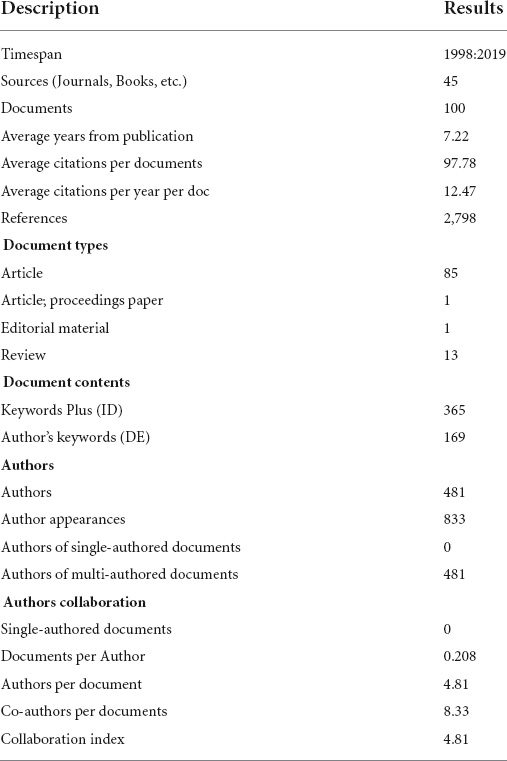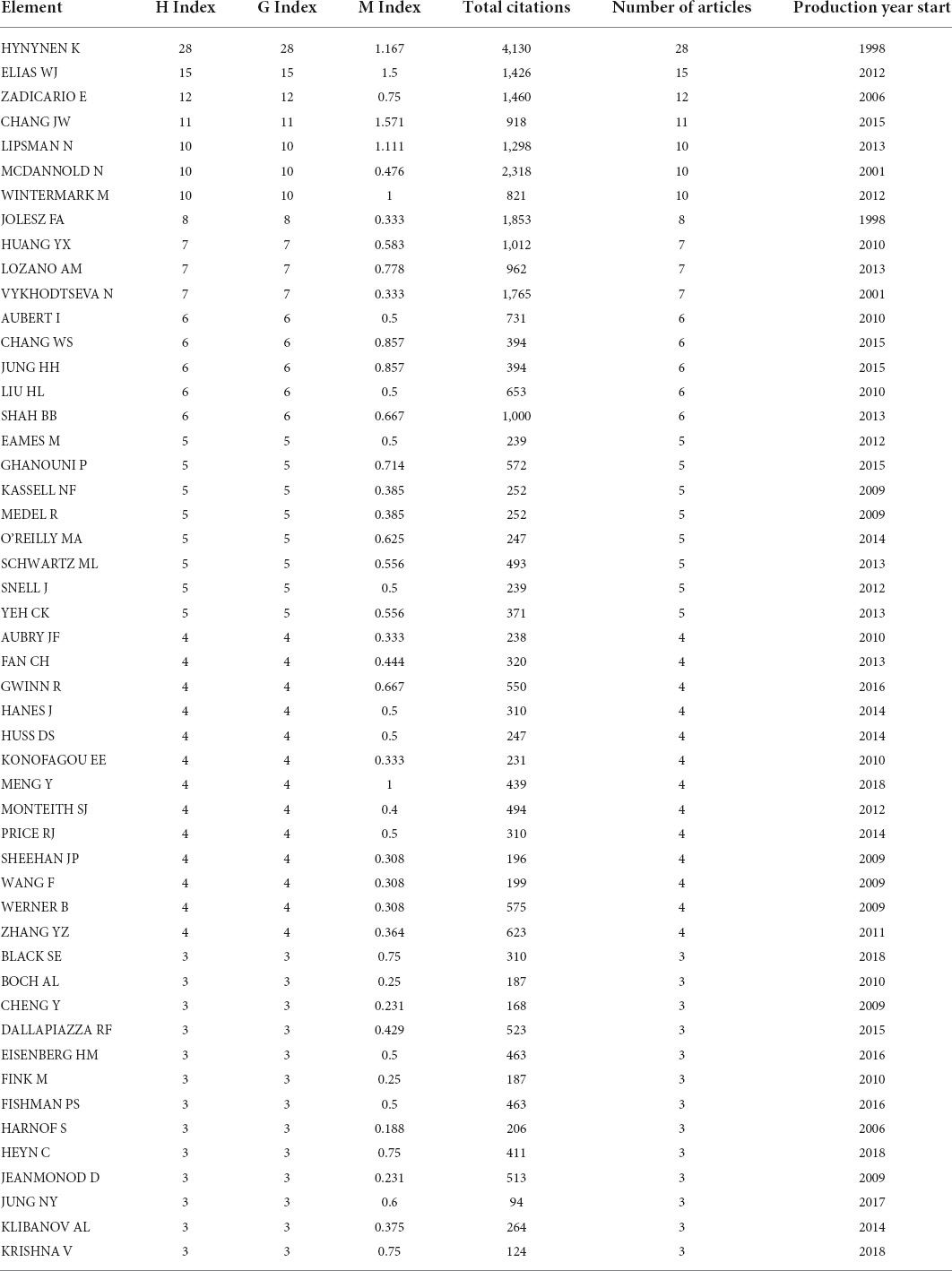- 1All India Institute of Medical Sciences, New Delhi, India
- 2Department of Neurosurgery, Rockefeller Neuroscience Institute, West Virginia University, Morgantown, WV, United States
- 3The University of North Carolina at Chapel Hill, Chapel Hill, NC, United States
Background: Diagnostic ultrasound has long been a part of a physician’s armamentarium, but transcranial focused ultrasound (FUS) is an emerging treatment of neurological disorders. Consequently, the literature in this field is increasing at a rapid pace.
Objective: This analysis was aimed to identify the top-cited articles on FUS to discern their origin, spread, current trends highlighting future impact of this novel neurosurgical intervention.
Methods: We searched the Web of Science database on 28th May 2021 and identified the top 100 cited articles. These articles were analyzed with various scientometric parameters like the authors, corresponding authors, country of corresponding author, journal of publication, year of publication. Citation based parameters including total citations, mean citations per article and mean citations, citation count, and the citation per year, citations per year and co-authors per document were studied as well in addition to Hirsch h-index, g-index, m-index, Bradford’s Law, Lotka’s law and Collaboration index.
Results: The 100 top-cited articles were published between 1998 and 2019 in 45 different journals. The average citations per document and citations per document per year were 97.78 and 12.47, respectively. The most prolific authors were Hynynen K (Medical Biophysics—Toronto), Elias WJ (Neurosurgery—Virginia), Zadicario (InSightec). The Journal of Neurosurgery published the most top-cited articles (n = 11), and most articles originated from the United States, followed by Canada. Among individual institutions, the University of Toronto was the most productive.
Conclusion: FUS is an emerging treatment of neurological disorders. With its increasing application, the FUS literature is increasing rapidly. Eleven countries contributed to the top 100 cited articles, with the top 2 countries (the United States and Canada) contributing to more than half of these articles.
Introduction
Diagnostic ultrasound has been a part of a physician’s armamentarium for the last seven decades. Focsused ultrasound (FUS) has emerged as a therapeutic option in the last few decades to successfully ablate soft tissue tumors such as uterine fibroids, breast carcinoma, and bone metastases (Fry et al., 1958; Fry and Fry, 1960; Cline et al., 1992, 1993, 1995; Hynynen et al., 1993a,b). Technological advances including development of a phased spherical array with a multielement transducer helmet and the implementation of magnetic resonance imaging guidance for real-time tissue temperature monitoring led to intracranial application for neurological disorders, specifically the movement disorders (Clement and Hynynen, 2002; Lipsman et al., 2014). FUS has evolved rapidly in the recent years, specifically in the functional neurosurgery with significant clinical and research publication.
Bibliometrics is a methodological approach from the library sciences that statistically analyses the citation counts of books, articles, and other publications to determine the influence and impact of the scientific publications. Scientometrics is a subfield of bibliometrics that studies science publications by using bibliometric methods to find author, article, and journal-level metrics (i.e., H-index, citation index, and journal impact factor, respectively). It provides a broad overview of the field’s direction, complements the expert peer review process, and is transparent and objective. Many scientometric analyses have been published in neurosurgery to find the 100-most cited articles on topics like endoscopic third ventriculostomy, ossified posterior longitudinal ligament, pallidotomy, and cervical spondylotic myelopathy (Zagzoog et al., 2018; Chen et al., 2019; Agrawal et al., 2021; Garg et al., 2021, 2022a,b; Zhao et al., 2021). However, there is no such article published on transcranial FUS. This scientometric analysis presents the top 100 cited articles published on transcranial FUS and further reports the most significant contributors (authors, institutes, and countries) along with the various scientometric indices.
Materials and methods
Search strategy
A systematic search of the Web of Science database was performed on 28th May 2021. The keywords used for literature search were—“MR guided focused ultrasound,” “MRgFUS,” “Magnetic resonance-guided focused ultrasound,” “Ultrasound Thalamotomy,” “Ultrasound Thalamotomy for Essential Tremor,” “Ultrasound Subthalamotomy, “focused ultrasound tremor,” “focused ultrasound tremor,” “ultrasound Parkinson,” “focused ultrasound ablation,” “transcranial focused ultrasound,” “focused ultrasound neuromodulation” and “focused ultrasound blood brain barrier opening.” The search results were screened and arranged in descending order of the number of citations, and articles were selected as per the following inclusion and exclusion criteria. FUS studies on transcranial FUS for neurological disorders, comparative study of FUS with DBS or radiofrequency (RF) for movement disorders, blood-brain barrier permeability, animal or cadaver research, targeted therapeutics and radiological aspect of FUS were included. FUS articles on non-cranial pathology were excluded.
Data and bibliometric parameters studied
The articles were arranged in descending order according to the number of citations. The various parameters analyzed were the title of the articles, authors, corresponding authors, country of corresponding author, journal of publication, year of publication. Citation based parameters including total citations, mean citations per article and mean citations, citation count, and the citation per year, citations per year and co-authors per document were studied as well. The following statistical parameters were considered during the analysis:
Hirsch h-index: authors number of publications and number of citations, reviewed in other articles.
g-index: is a variant of h-index which gives credit for the most cited papers. It is the highest rank where the sum of the citations is larger than the square of rank.
m-index: is another variant of the h-index that displays h-index per year since first publication.
Bradford’s Law: estimates the exponentially diminishing returns of searching for references in science journals was also studied.
Lotka’s law: which denotes the distribution of the number of articles published by the number of authors.
Collaboration index: it assigns a weighted credit to each author in a multi-author paper to capture a researcher’s scientific caliber better.
Analysis
The statistical analysis was performed using R software version 4.0.3 (R Foundation for Statistical Computing, Vienna, Austria) (Aria and Cuccurullo, 2017; R Core Team, 2022).
Results
Articles
The literature search yielded 2,500 articles, and we selected the 100 most cited articles which met the study inclusion and exclusion criteria (Hynynen et al., 2001, 2006; McDannold et al., 2005, 2010; Jordão et al., 2010; Bystritsky et al., 2011; Yoo et al., 2011; Jeanmonod et al., 2012; Park et al., 2012; Treat et al., 2012; Fan et al., 2013; Nance et al., 2014; Elias et al., 2016; Kovacs et al., 2017; Mainprize et al., 2019; Alzheimer’s disease in a mouse model: MR imaging-guided focused ultrasound targeted to the hippocampus opens the blood-brain barrier and improves pathologic abnormalities and behavior—PubMed). The included top-cited articles are summarized in Table 1.
These articles can be divided into three topics depending on the pathology type in which MRgFUS use has been described in the article. Equal numbers of articles involved human studies and animal studies (n = 41). Thirty-six studies were related to blood brain barrier (BBB) disruption and only three studies of these were human studies. Twenty-five studies focused on the role of FUS in patients with movement disorders and all were human studies. Three articles discussed the role of FUS in patients with pain, and a similar number of articles discussed the role of FUS for oncological indications in humans. Eleven articles discussed the technical aspects, while one clinical article described the use of FUS in patients with obsessive-compulsive disorders (OCD).
The article that received the maximum number of citations was “Non-invasive MR Imaging–guided Focal Opening of the Blood-Brain Barrier in Rabbits” published in 2001 in Radiology by Hynynen et al. and cited 855 times (Hynynen et al., 2001). The next two articles in the top 100 list, published in the New England Journal of Medicine, described the clinical application of MRgFUS in essential tremors. The first of these, titled “A Pilot Study of Focused Ultrasound Thalamotomy for Essential Tremor,” was a pilot trial that established the safety and efficacy of focused ultrasound thalamotomy in 15 patients suffering from essential tremor (Elias et al., 2013). Another article published in 2016, titled “A Randomized Trial of Focused Ultrasound Thalamotomy for Essential Tremor,” was a multicentre trial that confirmed the efficacy of focused ultrasound thalamotomy (Elias et al., 2016). The total citations per year for this article were 62.67, the maximum out of 100 cited articles.
Main information
These 100 articles were published in 45 journals over 22 years (1998–2019). There were 85 original and 15 review articles. The average number of years from the date of publication was 7.22. Interestingly, most of these articles were published recently: 2017 (15 articles), 2018 (12 articles), and 2014 (10 articles) (Figure 1A).
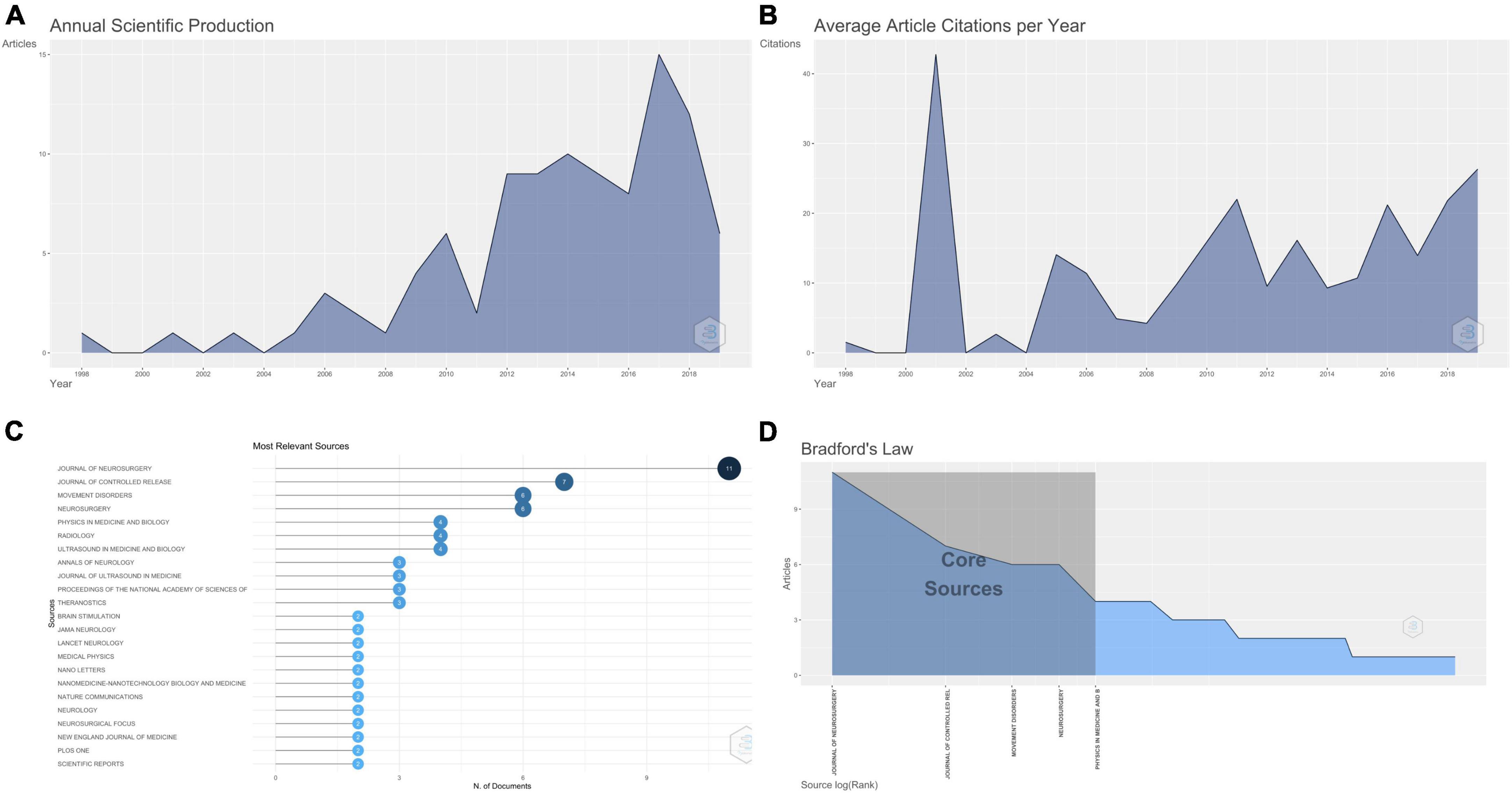
Figure 1. (A) Line graph showing the year wise number of articles published. (B) Line graph showing the year wise average citations per year. (C) Graph showing the number of articles among the top 100 cited articles on MRgFUS published in the different journals. (D) Graphical representation of Bradford’s law.
Average citations per document were 97.78, while average citations per year per document were 12.47 (Table 2). Maximum mean citations per article and mean citations per year were for the articles published in 2001 and were 855 and 42.75, respectively (Figure 1B).
Journals
Figure 1C shows the top 23 journals that published two or more articles. Journal of Neurosurgery had a maximum of 11 publications, followed by the Journal of Controlled Release (7), Movement Disorders (6 articles), and Neurosurgery (6 articles). Other journals that published at least one of these articles included Stereotactic and Functional Neurosurgery, the Journal of Neurology, Neurosurgery and Psychiatry, and the Journal of Magnetic Resonance Imaging.
Figure 1D shows the graphical representation of Bradford’s Law, which estimates the exponentially diminishing returns of searching for references in science journals. It shows that the Journal of Neurosurgery, Journal of Controlled Release, Movement Disorders, Neurosurgery and Physics in Medicine and Biology lie in Zone 1.
Figure 2A shows the journal-wise distribution of the total citations received by these articles. The articles published in Radiology were cited the most (1,064 citations), followed by New England Journal of Medicine (761 citations) and Journal of Neurosurgery (736 citations). The articles published in these journals were 4, 2, and 11, respectively. Figure 2B shows the journal impact measured in the H-index, with the Journal of Neurosurgery at the top. Figure 2C shows the source dynamics, i.e., the year-wise increase in the number of articles. Journal of Neurosurgery published the first article in 2012, and there has been a rapid increase in the published articles since.
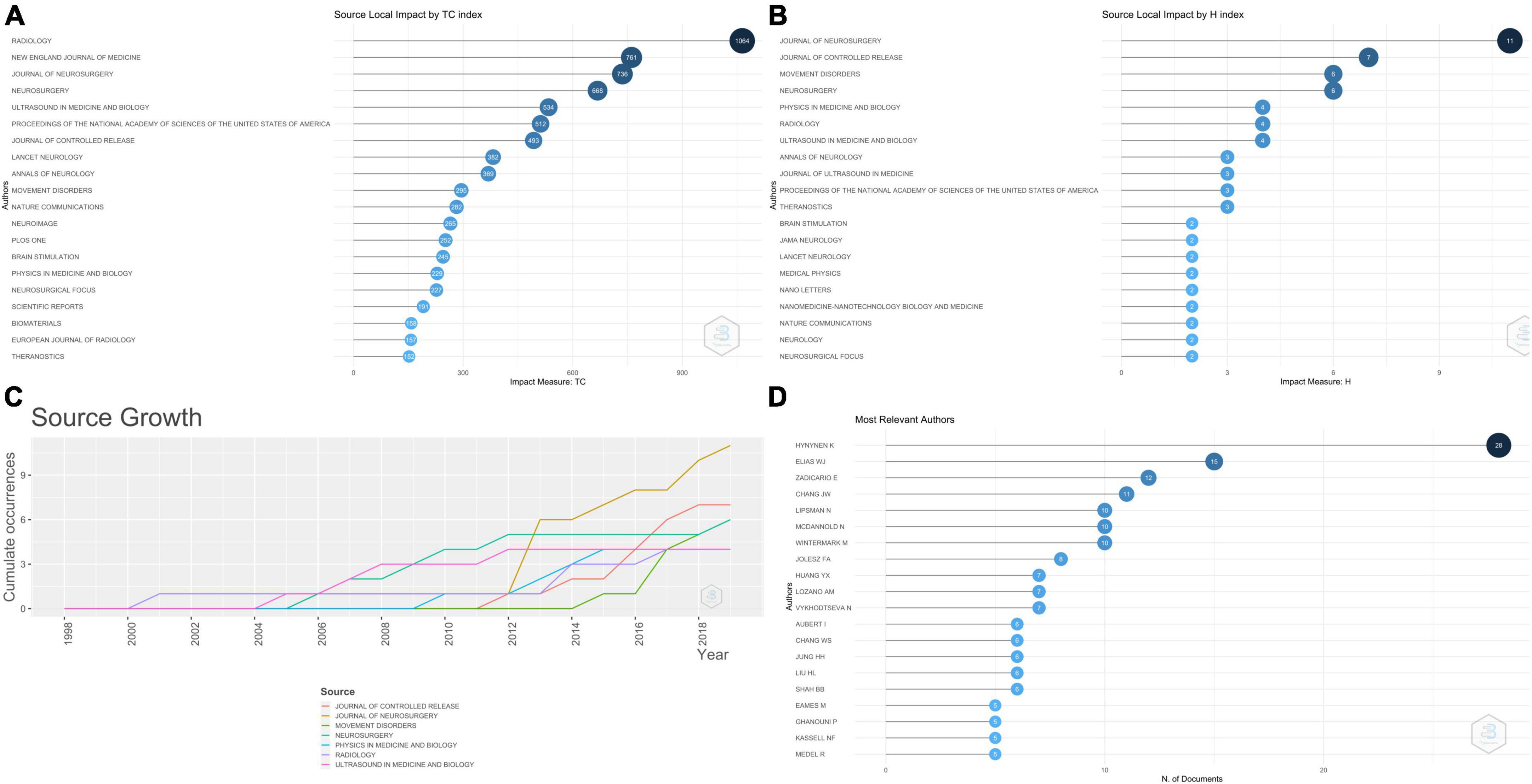
Figure 2. (A) Graph showing the top 20 journals with maximum impact in terms of total citations received by the articles included in the analysis. (B) Graph showing the top 20 journals with maximum impact in terms of H-index of the articles included in the analysis. (C) Line graph showing the “Source growth,” i.e., the cumulative number of articles published in the top seven journals. (D) Graph showing the number of articles among the top 100 cited articles on MRgFUS published by different authors.
Authors
These top 100 cited articles included 481 authors who made 833 appearances in these 100 articles. The number of co-authors per document was 8.33, with a collaboration index of 4.81. None of these articles were published by a single author.
Figure 2D shows the top 20 authors who published the maximum number of these articles. Hynynen K authored 28 out of these top 100, followed by Elias WJ (15 articles) and Zadicario (12 articles). Supplementary Figure 1 shows the top 20 authors’ production over time, with the size of the dots denoting the number of articles and the shade of the dots denoting the number of citations per year. Figure 3A shows the graphical representation of Lotka’s law, which denotes the distribution of the number of articles published by the number of authors. Most of the authors (85%) published 1 (70%) or 2 (15%) articles. Figure 3B shows the authors whose articles received the maximum number of citations. Articles authored by Hynynen received the maximum number of citations (4130). Table 3 shows the various indexes of the top 50 authors. H-index and g-index were maximum for Hynynen K, while the m-index, which considers the h-index and the number of years an author has been active for, was maximum for Chang JW (1.5710).
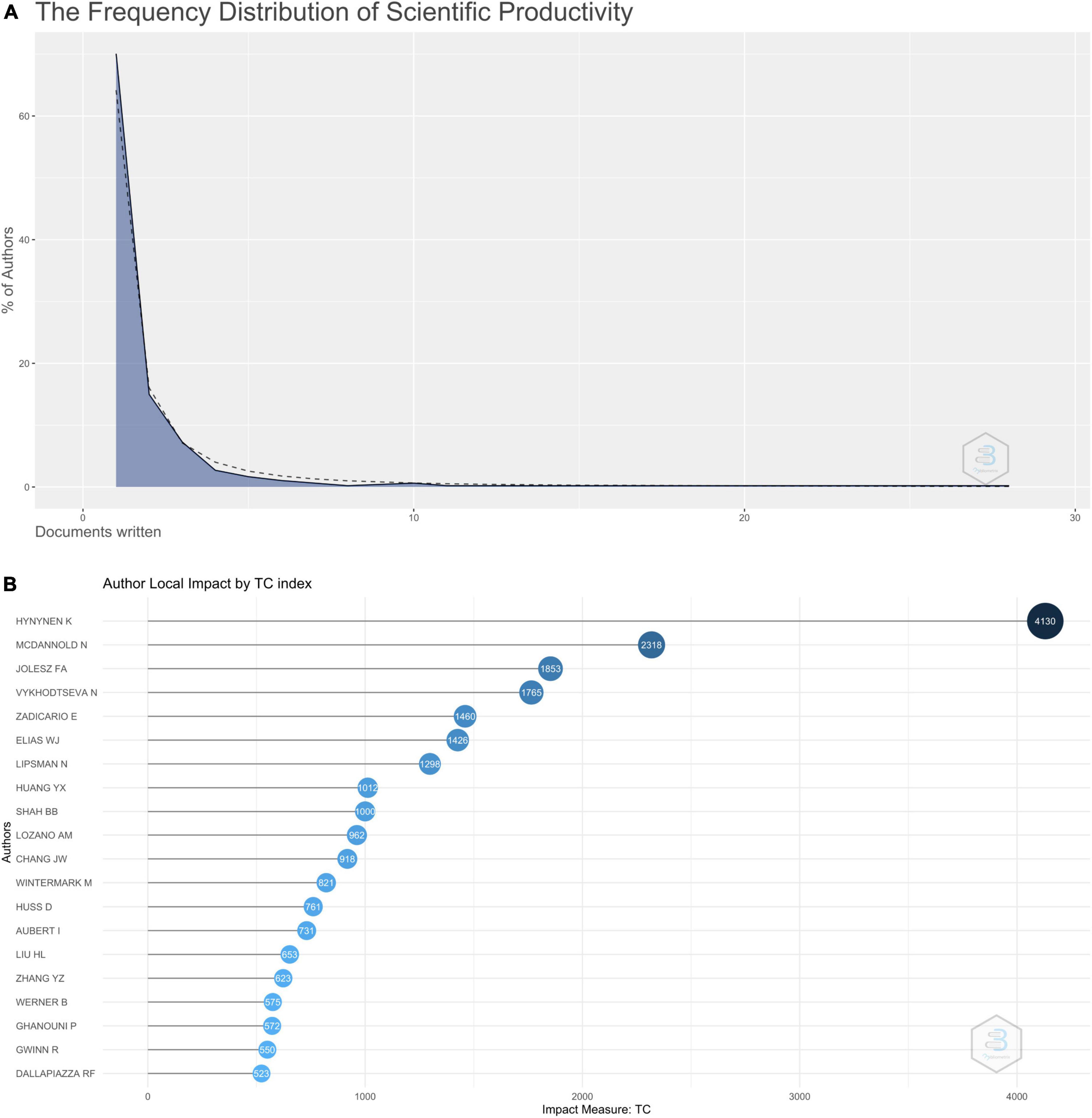
Figure 3. (A) Graphical representation of Lotka’s law. (B) Graph showing the top 20 authors with maximum impact as measured by total citations received by the top 100 cited articles on MRgFUS.
Affiliations and country
Figure 4A shows the top 20 universities which published the maximum number of articles. The maximum number of authors belong to the University of Toronto. Most universities were from the United States, Canada, Israel, and Taiwan.
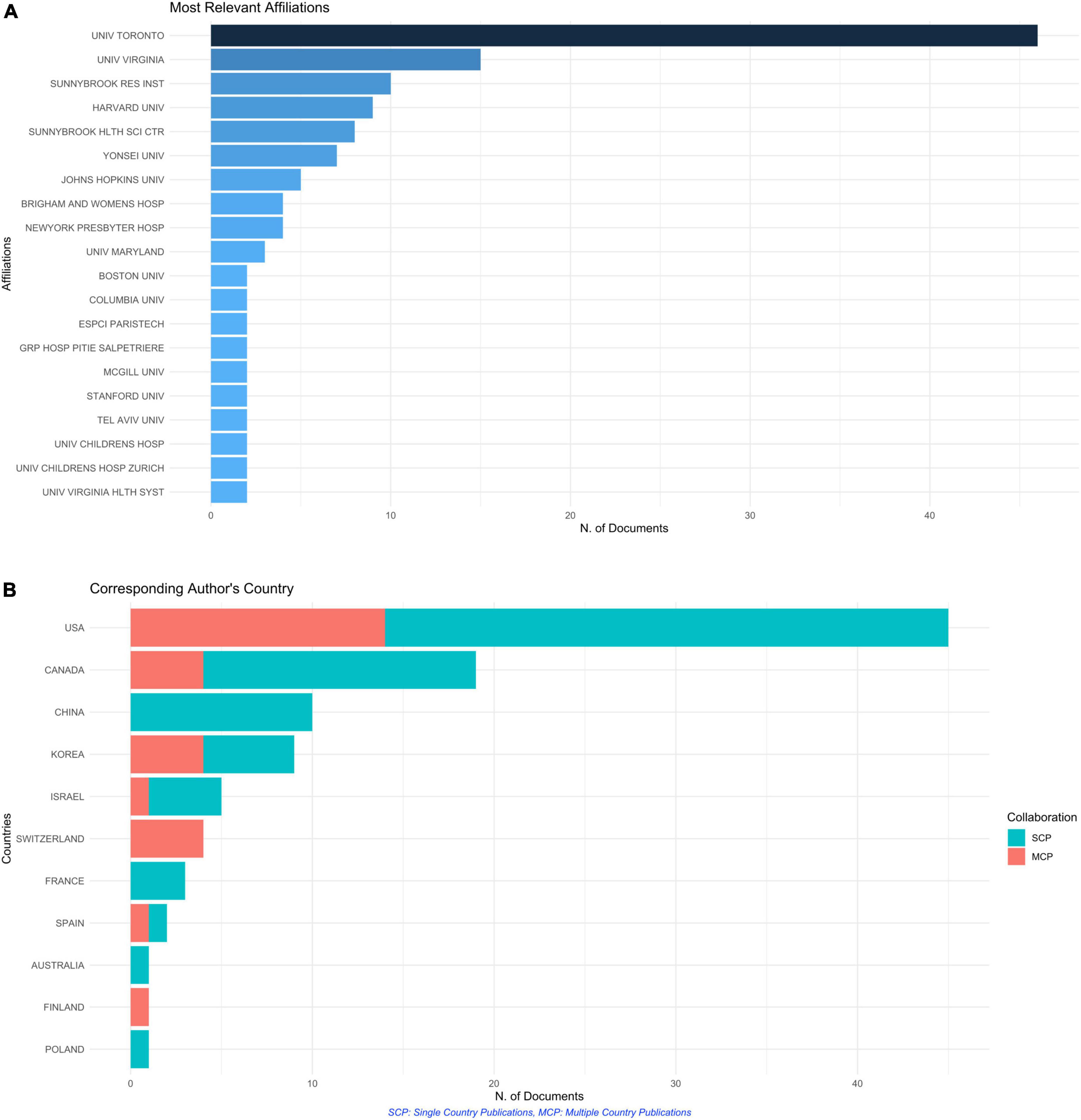
Figure 4. (A) Bar graph showing the top 20 affiliations of the authors who authored these top 100 cited articles. (B) Bar graph showing the countries which published the top 100 cited articles. Orange indicates publications with authors from more than one country (i.e., multicountry collaboration).
These top 100 cited articles were authored by corresponding authors from 11 countries, showing the limited availability of this technology. Figure 4B shows the country-wise distribution of the corresponding authors of these top 100 cited articles, with the maximum number of articles (n = 45) published from the United States. It was followed by Canada (19 articles) and China (10 articles). There were significant international collaborations in these articles, as shown by the orange bars in Figure 4B. The MCP ratio (Multicountry production ratio, which is the ratio of articles authored by authors belonging to more than one country to those authored by authors from one single country) was maximum (= 1) for the articles published by the authors from Switzerland and Finland, suggesting that all their articles had multicountry collaborations. Even the articles published from the United States had an MCP ratio of 0.31, with 14 out of 45 articles having authors from countries other than the United States. Figure 5A shows the world map with different shades of blue, showing the countries of all the authors (not corresponding authors alone) who were part of the author list of these 100 articles. It shows that most of the authors belonged to North America and Europe. Figure 5B shows the number of times the articles from a given country (as per the corresponding author) were cited. The articles from the United States were cited 5,125 times, followed by Canada (1,814 citations) and China (852 citations). However, average citations per article were maximum for the articles published from Switzerland (142), followed by the articles from the United States (113.9).
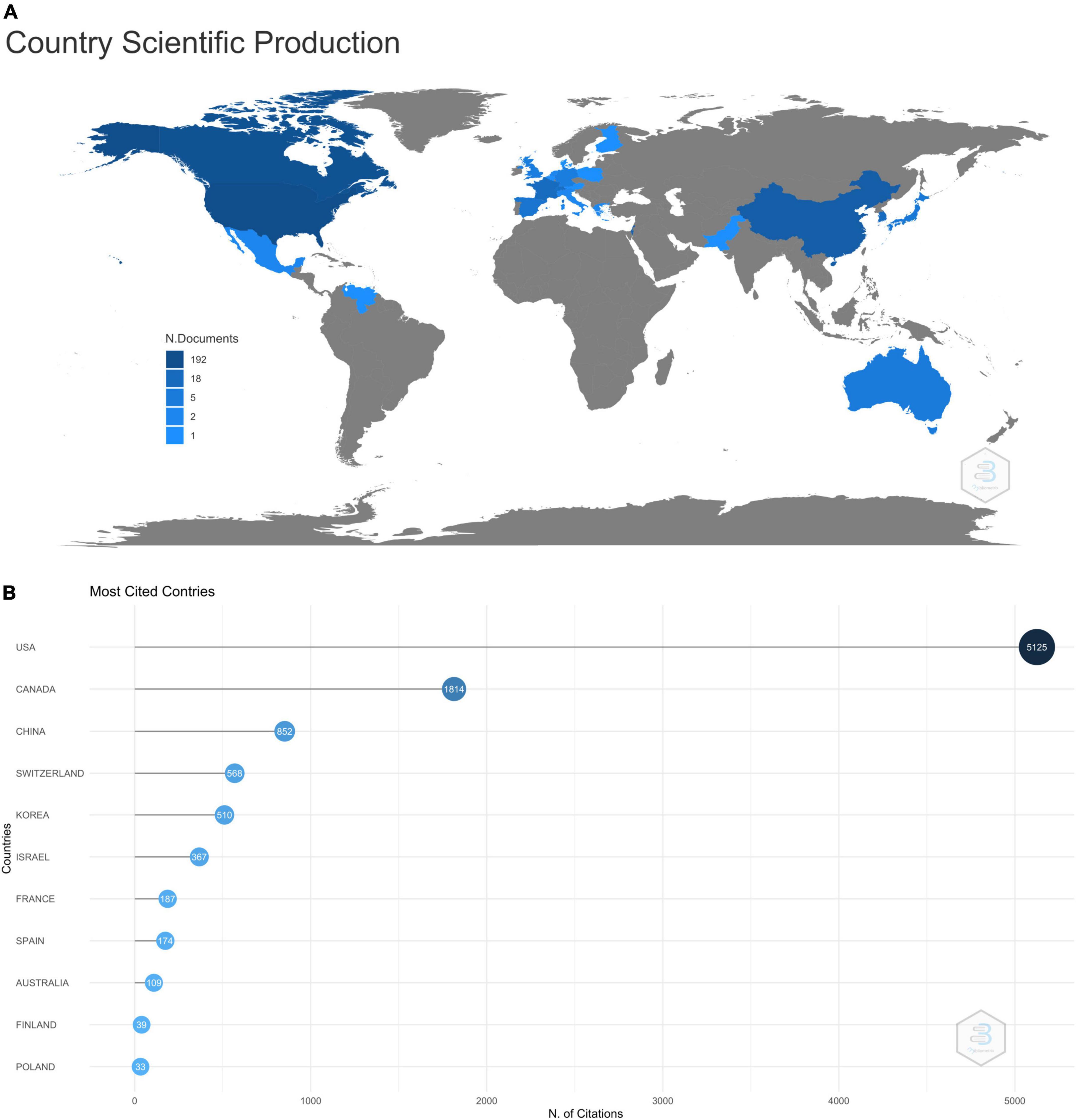
Figure 5. (A) Shade graded world map showing the distribution of scientific publications per the total number of authors from a country with the darker shade implying a greater number of authors from a country. (B) Graph showing the number of citations received by the articles published from various countries (as per the country of the corresponding author).
Figure 6A shows the number of times the top 20 cited articles were cited in all the journals, with the article by Hynynen et al. published in Radiology in 2011 cited 855 times. Figure 6B shows the number of times these top 100 cited articles were cited in these top 100 cited articles. Article by Hynynen et al. published in Radiology in 2011 was cited in 40 out of these top 100 cited articles.
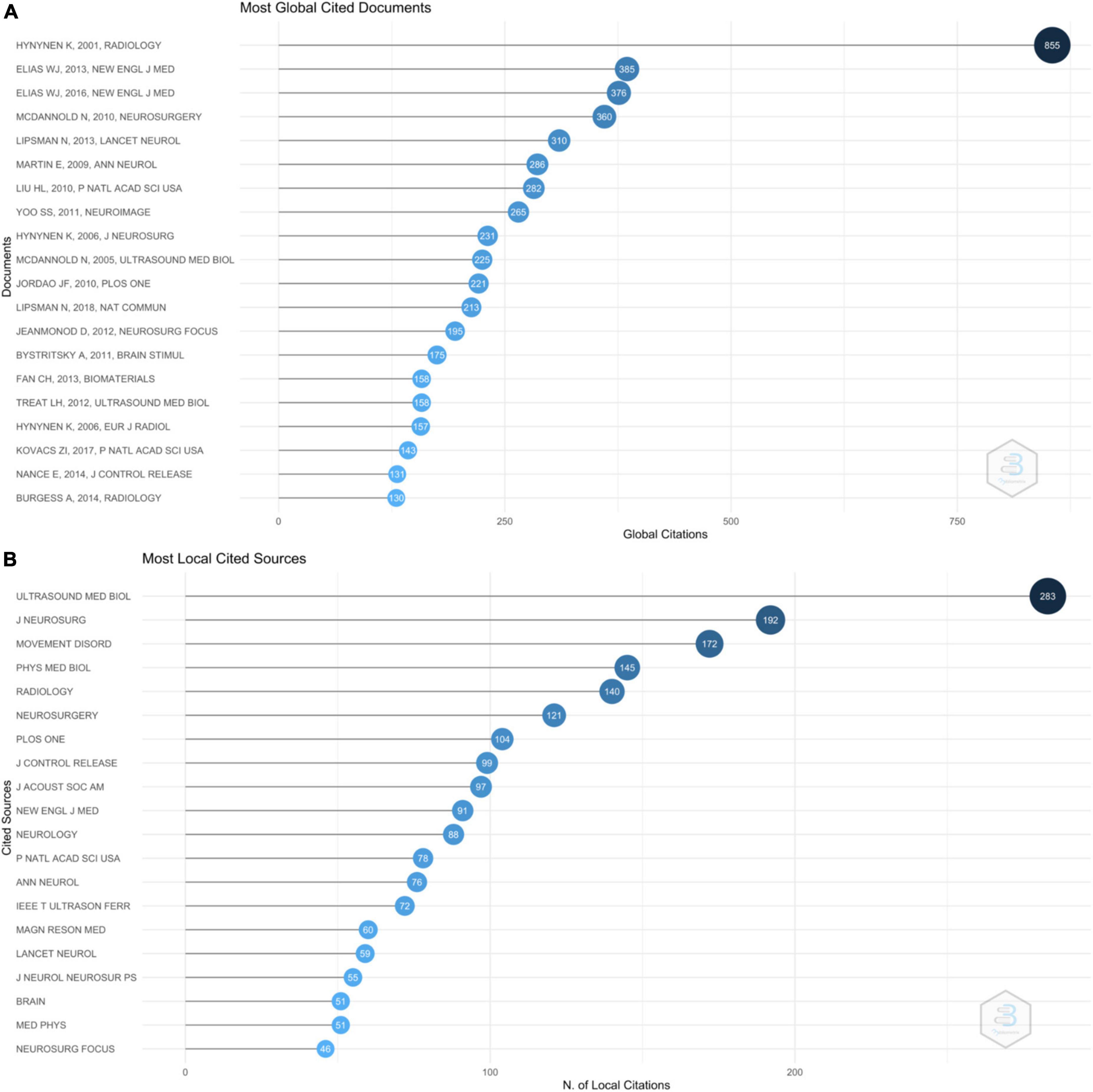
Figure 6. (A) Graph showing the number of times the top 20 cited articles were cited in all the journals. (B) Graph showing the number of times these top 100 cited articles were cited in these top 100 cited articles.
Supplementary Figure 2 shows the most commonly used keywords in these top 100 cited articles. The most common keyword was “focused ultrasound,” followed by “blood-brain barrier” and “essential tremor.”
Supplementary Figure 3 shows the three-field plot between the author country (left field), author (center field), and the keywords (right field). It can be appreciated that the countries with a maximum number of connections were Canada and the United States of America (USA). In contrast, the authors with the maximum number of connections were Hynynen K, Lozano AM, Lipsman N, and Elias WJ.
Discussion
MRgFUS is one of the most evolving field in the neurosurgery This scientometric analysis of the MRgFUS revealed some interesting and intriguing trends. First, these articles were published over the last 22 years, from 1998 to 2019. Obviously, it takes a few years for any article to garner many citations to feature in the top 100 cited articles and more importantly adoption in the clinical field given novelty of the technology. However, articles published recently, as recent as in 2019, appeared in this top 100 list. This reflects the rapid evolution and the acceptance of the field, not only by clinician but also the patients. As this technology is evolving and explored in newer neuropsychiatric indications, the scientific publications and their citations are going to be more voluminous and robust in near future.
Secondly, only 11 countries contributed to these top 100 cited articles, with the top 2 countries (the United States and Canada) contributing to more than half of these articles. As MRgFUS is a new technology and its availability is yet limited. There was no article from low to middle-income countries, perhaps due to the high cost of initial set up. The low acceptance of a surgical procedure for non-life-threatening diseases may also contribute to the limited interest of many countries. Although the average citations per document of these articles were less when compared with the top 100 cited articles on other pathologies, the average citations per document per year were higher (Agrawal et al., 2021). This reflects not only that most of these articles were published recently but also that they are being increasingly cited and applied increasingly to clinical and translational research.
The analysis revealed that 41 articles were based on animal or cadaveric studies to study the preclinical aspects of focused ultrasound. It again reflects the novelty of the technology and value of translational impact in clinical neurosurgery. Amongst the human studies, most of the articles (n = 25) described the use of MRgFUS in various movement disorders, with essential tremor being the commonest pathology. The other rare pathologies where the use of MRgFUS has been described in these studies are Parkinson’s disease, dystonia, and OCD.
There was one animal study and four human trials in the top five cited articles (Hynynen et al., 2001; McDannold et al., 2010; Elias et al., 2013, 2016; Lipsman et al., 2014). The highest cited article was an animal study. Hynynen et al. studied if focused ultrasound beams can be used to locally open the blood-brain barrier without damage to surrounding brain tissue and if magnetic resonance (MR) imaging can be used to monitor this procedure in this article (Hynynen et al., 2001). The authors established that the BBB could be consistently opened with transcranial FUS, opening a new translational field in neurological disorders.
Three out of four human trials were proof of concept studies or pilot studies (McDannold et al., 2010; Elias et al., 2013, 2016). The second most cited article was a pilot study by Elias et al. and published in NEJM in 2013 (Elias et al., 2013). The authors reported total tremor and disability scores improved from 54.9 to 24.3 (P = 0.001) and 18.2 to 2.8 (P = 0.001), respectively in 15 ET patients treated with FUS thalamotomy. This pilot trial was followed by a multicentric randomized controlled trial, published in NEJM in 2016, comparing the efficacy of unilateral focused ultrasound thalamotomy with a sham procedure in 76 patients with ET (Elias et al., 2016). The authors observed that hand-tremor scores improved more after focused ultrasound thalamotomy than after sham procedure, and the improvement was maintained 12 months after thalamotomy. Improvement in secondary outcome measures assessing disability and quality of life was also noticed.
These 100 top cited articles were published in in 45 various neurosurgical, neurological, radiological, and basic sciences research journals, including high-impact journals like NEJM, JAMA Neurology, Nature communications, Annals of Neurology, Movement Disorders, Radiology, and Neurosurgery. This diversity may represent the interest from different specialties, leading to faster advancements in this technology and a steep increase in the amount of literature. Journal of Neurosurgery published 11 out of these top 100, perhaps related to the fact that neurosurgeons are the end users of this technology and have been actively involved in FUS-related research.
The top-cited article by Hynynen guided Radiology to be the maximally cited journal out of all the journals in which these articles were published (Hynynen et al., 2001).
One of the important finding noted in this study was that the number of co-authors per document was 8.33, indicating that these articles were published by research teams with larger collaborative members and/or multicentric collaboration. Moreover, 15% of the authors contributed to more than two articles in the top 100 cited articles. Hynynen K, a Professor of Medical Biophysics at the University of Toronto, was the top contributor in these journals, contributing to 28 out of these top 100 cited articles, followed by Elias WJ (15 articles) and Zadicario (12 articles). The second highest contributor to these articles is Elias WJ, a Professor of Neurological Surgery at the University of Virginia. The third highest contributor was Eyal Zadicario, who is a part of the InSightec (manufacturer) team. Hynynen K has contributed to FUS research for more than three decades and is the lead author of the highly cited article in this list.
Limitations
There are some inherent drawbacks of bibliometric analysis. The reasons why a paper is cited multiple times may be diverse and may not accurately reflect the influence of the study in question (Garfield, 1979). Sole reliance on these indicators can lead to missing specific papers reporting (Allen et al., 2009). Similarly, recent publications on the topic and young researchers might not have accrued enough citations to make it to the list of top 100 articles. One of the inherent limitation of this study is that the search criteria included both the animal and human studies. It is not uncommon to have lesser citation of the animal studies than human studies, given recent and increasingly more acceptance in clinical trials and clinical practise. The citation matrix alone should not be taken as the sole criteria about the value and rigor of the study. The search was conducted on Web of Science, the most common database used for bibliometric analyses, but still, fallacious exclusions of some articles could have happened due to the keyword-specific results obtained.
Conclusion
MRgFUS is one of the fastest evolving field in neurosurgery, specifically functional neurosurgery with increasing studies in recent years. As novel indications are studied, it is crucial to identify the most important topics and contributors to the field as scientific literature expands to guide clinician and research in the field. Most of the top 100 cited articles comes from North America and Europe, with the United States and Canada contributing to more than half of the articles on MRgFUS. The top 100 cited articles also highlight the access of MRgFUS to developed countries and healthcare disparity in access of MrgFUS to developing countries.
Author contributions
KG: conceptualization, methodology, software, writing, rewriting and editing, data curation, writing—original draft preparation, visualization, investigation, software, and validation. MR: conceptualization, writing, rewriting and editing, writing—original draft preparation, visualization, investigation, supervision, software, and validation. VK: conceptualization, methodology, rewriting and editing, and supervision. MS and AR: methodology, rewriting and editing, and supervision. All authors contributed to the article and approved the submitted version.
Conflict of interest
The authors declare that the research was conducted in the absence of any commercial or financial relationships that could be construed as a potential conflict of interest.
Publisher’s note
All claims expressed in this article are solely those of the authors and do not necessarily represent those of their affiliated organizations, or those of the publisher, the editors and the reviewers. Any product that may be evaluated in this article, or claim that may be made by its manufacturer, is not guaranteed or endorsed by the publisher.
Supplementary material
The Supplementary Material for this article can be found online at: https://www.frontiersin.org/articles/10.3389/fnhum.2022.981571/full#supplementary-material
Supplementary Figure 1. Graph showing the year wise distribution of number of articles among the top 100 cited articles on MRgFUS published by different authors and the number of citations received by articles published in different years.
Supplementary Figure 2. Graph showing most frequently used keywords in the top 100 cited articles on MRgFUS.
Supplementary Figure 3. Three fields plot showing the predominant countries, surgeons and the key areas of work from the top 100 cited articles on MRgFUS.
References
Agrawal, M., Garg, K., Samala, R., Rajan, R., and Singh, M. (2021). A Scientometric Analysis of the 100 Most Cited Articles on Pallidotomy. Stereotact. Funct. Neurosurg. 99, 463–473. doi: 10.1159/000516237
Allen, L., Jones, C., Dolby, K., Lynn, D., and Walport, M. (2009). Looking for landmarks: The role of expert review and bibliometric analysis in evaluating scientific publication outputs. PLoS One 4:e5910. doi: 10.1371/journal.pone.0005910
Aria, M., and Cuccurullo, C. (2017). bibliometrix: An R-tool for comprehensive science mapping analysis. J. Informetr. 11, 959–975. doi: 10.1016/j.joi.2017.08.007
Bystritsky, A., Korb, A. S., Douglas, P. K., Cohen, M. S., Melega, W. P., Mulgaonkar, A. P., et al. (2011). A review of low-intensity focused ultrasound pulsation. Brain Stimul. 4, 125–136. doi: 10.1016/j.brs.2011.03.007
Chen, Y. C., Kuo, C. H., Cheng, C. M., and Wu, J. C. (2019). Recent advances in the management of cervical spondylotic myelopathy: Bibliometric analysis and surgical perspectives. J. Neurosurg. Spine 31, 299–309. doi: 10.3171/2019.5.SPINE18769
Clement, G. T., and Hynynen, K. (2002). A non-invasive method for focusing ultrasound through the human skull. Phys. Med. Biol. 47, 1219–1236. doi: 10.1088/0031-9155/47/8/301
Cline, H. E., Hynynen, K., Watkins, R. D., Adams, W. J., Schenck, J. F., Ettinger, R. H., et al. (1995). Focused US system for MR imaging-guided tumor ablation. Radiology 194, 731–737. doi: 10.1148/radiology.194.3.7862971
Cline, H. E., Schenck, J. F., Hynynen, K., Watkins, R. D., Souza, S. P., and Jolesz, F. A. (1992). MR-guided focused ultrasound surgery. J. Comput. Assist. Tomogr. 16, 956–965. doi: 10.1097/00004728-199211000-00024
Cline, H. E., Schenck, J. F., Watkins, R. D., Hynynen, K., and Jolesz, F. A. (1993). Magnetic resonance-guided thermal surgery. Magn. Reson. Med. 30, 98–106. doi: 10.1002/mrm.1910300115
Elias, W. J., Huss, D., Voss, T., Loomba, J., Khaled, M., Zadicario, E., et al. (2013). A pilot study of focused ultrasound thalamotomy for essential tremor. N. Engl. J. Med. 369, 640–648. doi: 10.1056/NEJMoa1300962
Elias, W. J., Lipsman, N., Ondo, W. G., Ghanouni, P., Kim, Y. G., Lee, W., et al. (2016). A Randomized Trial of Focused Ultrasound Thalamotomy for Essential Tremor. N. Engl. J. Med. 375, 730–739. doi: 10.1056/NEJMoa1600159
Fan, C. H., Ting, C. Y., Lin, H. J., Wang, C. H., Liu, H. L., Yen, T. C., et al. (2013). SPIO-conjugated, doxorubicin-loaded microbubbles for concurrent MRI and focused-ultrasound enhanced brain-tumor drug delivery. Biomaterials 34, 3706–3715. doi: 10.1016/j.biomaterials.2013.01.099
Fry, F. J., Ades, H. W., and Fry, W. J. (1958). Production of reversible changes in the central nervous system by ultrasound. Science 127, 83–84. doi: 10.1126/science.127.3289.83
Fry, W. J., and Fry, F. J. (1960). Fundamental neurological research and human neurosurgery using intense ultrasound. IRE Trans. Med. Electron. ME-7, 166–181. doi: 10.1109/iret-me.1960.5008041
Garfield, E. (1979). Is citation analysis a legitimate evaluation tool? Scientometrics 1, 359–375. doi: 10.1007/BF02019306
Garg, K., Chaurasia, B., Gienapp, A. J., Splavski, B., and Arnautovic, K. I. (2022b). Bibliometric Analysis of Major Neurosurgical Publications 2011–2020, Part 2: Journal, Author, Yearly Publication Trends, and Citation Related Metrics. Acta Informat. Med. 30, 11–17. doi: 10.5455/aim.2022.30.11-17
Garg, K., Agosti, E., Chaurasia, B., and Fontanella, M. M. (2022a). Ten Years of Publications: Scientometric Comparison of Major Neurosurgical Journals. World Neurosurg. 159, 168–178.e13. doi: 10.1016/j.wneu.2021.12.095
Garg, K., Chaurasia, B., Gienapp, A. J., Splavski, B., and Arnautovic, K. I. (2021). Bibliometric Analysis of Publications From 2011-2020 in 6 Major Neurosurgical Journals (Part 1): Geographic, Demographic, and Article Type Trends. World Neurosurg. 157, 125–134. doi: 10.1016/j.wneu.2021.10.091
Hynynen, K., Damianou, C., Darkazanli, A., Unger, E., and Schenck, J. F. (1993a). The feasibility of using MRI to monitor and guide noninvasive ultrasound surgery. Ultrasound Med. Biol. 19, 91–92. doi: 10.1016/0301-5629(93)90022-g
Hynynen, K., Darkazanli, A., Unger, E., and Schenck, J. F. (1993b). MRI-guided noninvasive ultrasound surgery. Med. Phys. 20, 107–115. doi: 10.1118/1.597093
Hynynen, K., McDannold, N., Clement, G., Jolesz, F. A., Zadicario, E., Killiany, R., et al. (2006). Pre-clinical testing of a phased array ultrasound system for MRI-guided noninvasive surgery of the brain–a primate study. Eur. J. Radiol. 59, 149–156. doi: 10.1016/j.ejrad.2006.04.007
Hynynen, K., McDannold, N., Vykhodtseva, N., and Jolesz, F. A. (2001). Noninvasive MR imaging-guided focal opening of the blood-brain barrier in rabbits. Radiology 220, 640–646. doi: 10.1148/radiol.2202001804
Jeanmonod, D., Werner, B., Morel, A., Michels, L., Zadicario, E., Schiff, G., et al. (2012). Transcranial magnetic resonance imaging-guided focused ultrasound: Noninvasive central lateral thalamotomy for chronic neuropathic pain. Neurosurg. Focus 32:E1. doi: 10.3171/2011.10.FOCUS11248
Jordão, J. F., Ayala-Grosso, C. A., Markham, K., Huang, Y., Chopra, R., McLaurin, J., et al. (2010). Antibodies targeted to the brain with image-guided focused ultrasound reduces amyloid-beta plaque load in the TgCRND8 mouse model of Alzheimer’s disease. PLoS One 5:e10549. doi: 10.1371/journal.pone.0010549
Kovacs, Z. I., Kim, S., Jikaria, N., Qureshi, F., Milo, B., Lewis, B. K., et al. (2017). Disrupting the blood-brain barrier by focused ultrasound induces sterile inflammation. Proc. Natl. Acad. Sci. U. S. A. 114, E75–E84. doi: 10.1073/pnas.1614777114
Lipsman, N., Mainprize, T. G., Schwartz, M. L., Hynynen, K., and Lozano, A. M. (2014). Intracranial applications of magnetic resonance-guided focused ultrasound. Neurotherapeutics 11, 593–605. doi: 10.1007/s13311-014-0281-2
Mainprize, T., Lipsman, N., Huang, Y., Meng, Y., Bethune, A., Ironside, S., et al. (2019). Blood-Brain Barrier Opening in Primary Brain Tumors with Non-invasive MR-Guided Focused Ultrasound: A Clinical Safety and Feasibility Study. Sci. Rep. 9:321. doi: 10.1038/s41598-018-36340-0
McDannold, N., Clement, G. T., Black, P., Jolesz, F., and Hynynen, K. (2010). Transcranial magnetic resonance imaging- guided focused ultrasound surgery of brain tumors: Initial findings in 3 patients. Neurosurgery 66, 323–332. doi: 10.1227/01.NEU.0000360379.95800.2F
McDannold, N., Vykhodtseva, N., Raymond, S., Jolesz, F. A., and Hynynen, K. (2005). MRI-guided targeted blood-brain barrier disruption with focused ultrasound: Histological findings in rabbits. Ultrasound Med. Biol. 31, 1527–1537. doi: 10.1016/j.ultrasmedbio.2005.07.010
Nance, E., Timbie, K., Miller, G. W., Song, J., Louttit, C., Klibanov, A. L., et al. (2014). Non-invasive delivery of stealth, brain-penetrating nanoparticles across the blood-brain barrier using MRI-guided focused ultrasound. J. Control. Release 189, 123–132. doi: 10.1016/j.jconrel.2014.06.031
Park, E. J., Zhang, Y. Z., Vykhodtseva, N., and McDannold, N. (2012). Ultrasound-mediated blood-brain/blood-tumor barrier disruption improves outcomes with trastuzumab in a breast cancer brain metastasis model. J. Control. Release 163, 277–284. doi: 10.1016/j.jconrel.2012.09.007
R Core Team (2022). R: A language and environment for statistical computing. Vienna: R foundation for statistical computing.
Treat, L. H., McDannold, N., Zhang, Y., Vykhodtseva, N., and Hynynen, K. (2012). Improved anti-tumor effect of liposomal doxorubicin after targeted blood-brain barrier disruption by MRI-guided focused ultrasound in rat glioma. Ultrasound Med. Biol. 38, 1716–1725. doi: 10.1016/j.ultrasmedbio.2012.04.015
Yoo, S. S., Bystritsky, A., Lee, J. H., Zhang, Y., Fischer, K., Min, B. K., et al. (2011). Focused ultrasound modulates region-specific brain activity. Neuroimage 56, 1267–1275. doi: 10.1016/j.neuroimage.2011.02.058
Zagzoog, N., Attar, A., and Reddy, K. (2018). The 50 most cited publications in endoscopic third ventriculostomy: A bibliometric analysis. J. Neurosurg. Pediatr. 23, 145–152. doi: 10.3171/2018.2.PEDS17354
Keywords: focused ultrasound, neurosurgery, Parkinson’s disease, essential tremor, MRI, FUS
Citation: Garg K, Ranjan M, Krishna V, Singh M and Rezai A (2022) A scientometric analysis of the 100 most cited articles on magnetic resonance guided focused ultrasound. Front. Hum. Neurosci. 16:981571. doi: 10.3389/fnhum.2022.981571
Received: 29 June 2022; Accepted: 15 August 2022;
Published: 12 September 2022.
Edited by:
Nan-kuei Chen, University of Arizona, United StatesReviewed by:
Gregory Noetscher, Combat Capabilities Development Command United States Army, United StatesFrancesca Di Giuliano, University of Rome Tor Vergata, Italy
Copyright © 2022 Garg, Ranjan, Krishna, Singh and Rezai. This is an open-access article distributed under the terms of the Creative Commons Attribution License (CC BY). The use, distribution or reproduction in other forums is permitted, provided the original author(s) and the copyright owner(s) are credited and that the original publication in this journal is cited, in accordance with accepted academic practice. No use, distribution or reproduction is permitted which does not comply with these terms.
*Correspondence: Manish Ranjan, ZHJtYW5pc2hyYW5qYW5AZ21haWwuY29t
 Kanwaljeet Garg
Kanwaljeet Garg Manish Ranjan
Manish Ranjan Vibhor Krishna
Vibhor Krishna Manmohan Singh1
Manmohan Singh1 Ali Rezai
Ali Rezai
